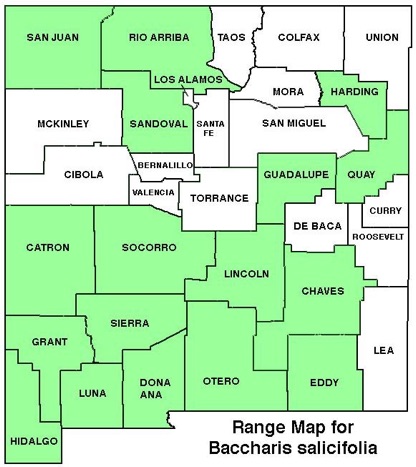WILDFLOWERS OF NEW MEXICO

Reaching 13 feet tall (4 m) along and streams and drainages, this upright, thicket-forming shrub has long slender branches and narrow, willow-like leaves. Note the flower heads are unisexual with dense clusters of short, silvery-white pappus hairs.
FLOWERS: March–October. Clusters terminal, flat-topped with disk florets only; Female florets white, males white to yellowish; pappus (bristle-like hairs) silvery-white, 1/8–1/4 inch long (3-6 mm). Phyllaries lance-shaped, 1/16–3/16 inch long 2-4 mm, midribs distinct, medians green to reddish, tips green to reddish-purple.
LEAVES: Alternate, deciduous, on short stalks or not (sessile); blades narrow, willow-like, lance-elliptic, 1 1/4–6 inches long (3–15 cm) by 3/16–3/4 inch wide (5–20 mm); margins usually finely serrated from base to tip with scattered teeth less than 1 mm long, surfaces gland-dotted, resinous, tips pointed to tapering.
HABITAT: Moist soils of riparian woodlands, stream banks, washes, drainages; desert grasslands and scrub, pinyon-juniper foothills.
ELEVATION: 3,500–7,000 feet
RANGE: AZ, CA, CO, NM, NV, TX, UT.
SIMILAR SPECIES: Willow Baccharis, B. salicina, has broader leaves with smooth margins or with teeth near tip, and pappus bristles 5/15–1/2 inch long (8–12 mm).
NM COUNTIES: Widespread, common, mostly in the sw quarter of the state in low- to mid-elevation, moist habitats; Catron, Chaves, Dona Ana, Eddy, Guadalupe, Grant, Harding, Hidalgo, Lincoln, Luna, Otero, Quay, Rio Arriba, San Juan, Sandoval, Sierra, Socorro.









SEEP-WILLOW, MULE FAT
BACCHARIS SALICIFOLIA
Aster family, Asteraceae
Deciduous shrub


















THE CONTENTS OF THIS WEBSITE ARE COPYRIGHTED AND CANNOT BE USED
WITHOUT PERMISSION OF GEORGE OXFORD MILLER
















EMAIL ME




























Nectar-rich flowers attract many kinds of pollinators.
Leaves are narrow with small, widely-spaced teeth along the margins (arrow).
Seep-willow can reach 13 feet tall and form thickets along waterways.
Seep-willow pappus bristles are silvery to tawny and up to 1/4 inch long (arrow).

















